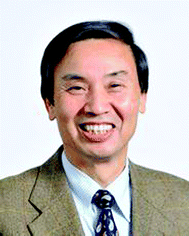Themed issue: flexible electronics
Guozhen
Shen
a,
Lei
Liao
b,
Chongwu
Zhou
c and
Yoshio
Bando
d
aState Key Laboratory for Superlattices and Microstructures, Institute of Semiconductors, Chinese Academy of Sciences, Beijing 100083, P. R. China. E-mail: gzshen@semi.ac.cn
bDepartment of Physics, Wuhan University, Wuhan 430074, P. R. China. E-mail: leiliao@whu.edu.cn
cDepartment of Electrical Engineering, University of Southern California, Los Angeles, CA 90089, USA. E-mail: chongwuz@usc.edu
dNational Institute of Materials Sciences, Namiki 1-1-1, Tsukuba, Ibaraki, Japan. E-mail: Bando.Yoshio@nims.go.jp
 Guozhen Shen |
 Lei Liao |
 Chongwu Zhou |
 Yoshio Bando |
Electronic systems that can cover large areas on flexible substrates have received increasing attention in the last couple of decades because they enable classes of applications that lie outside of those easily addressed with wafer-based electronics. Examples include flexible displays, electronic textiles, sensory skins, active antennas, etc. This type of electronics, sometimes referred to as macroelectronics, differs from established microelectronic and nanoelectronic systems, where progress is driven primarily by reducing the critical dimensions of the functional elements (e.g., channel lengths and dielectric thicknesses in transistors) to increase the speed and computing capacity and to reduce the operating voltages.
Because of the rapid development of flexible electronics in recent years, we would like to take the opportunity to publish this themed issue focusing on flexible electronics. Our aim is to highlight the remarkable contributions made by leading scientists in this important research area and the broad impacts of flexible electronics.
In this themed issue, many experts in the relevant fields discuss several efficient ways, such as electrospinning, peeling-off, chemical vapor deposition, and solution processes, to produce high quality flexible devices including flexible thin-film transistors (TFTs), RFIDs, photodetectors, sensors, and emitters.
Since the development of elastomeric conductors that possess both high conductivity and stretchability is a crucial but difficult step, paper electrodes, transparent composite electrodes, etc. have been developed to address this issue.
To fulfill fully flexible electronics, the energy units should be flexible as well. Exciting samples included in this themed issue are organic photovoltaic devices, dye-sensitized solar cells and supercapacitors.
Although it is not possible to include all the topics in this quickly developing field, we hope this small collection of papers can provide the readers with an overview of the recent progress achieved in this exciting area, the potential broader impact of the studies in flexible electronics and inspire many more to enter this field.
As Guest Editors, we would like to thank all the authors for their efforts in submitting a wide variety of high-quality peer-reviewed articles that advance state-of-the-art research. We are also grateful to the editorial and production staff of J. Mater. Chem. C for their superb assistance. Finally, we hope that this timely themed issue will provide a valuable reference and perspective for the research community working in this exciting field.
Acknowledgements
We thank the Department of Information Sciences, National Natural Science Foundation of China (NSFC) for the support received for this themed issue.| This journal is © The Royal Society of Chemistry 2014 |
